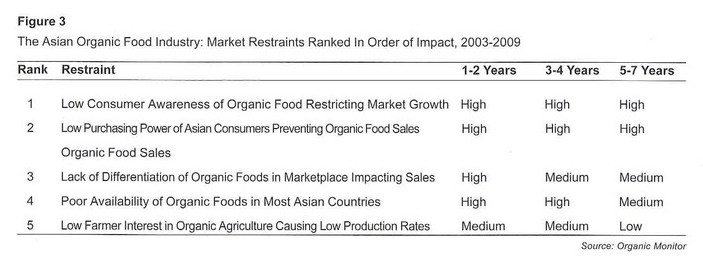Market Drivers
A market driver is a factor that has a positive effect on the market, either in terms of raising sales or consumption of organic foods. Figure 2 lists the major factors that are driving growth in the Asian organic food industry. The market drivers are listed in order of importance and the impact is given over the forecast period. 2003-2009.
The largest market for organic foods is in Japan and growth is being driven by factors like consumers’ fears for food safety and growing consumer interest in natural products. The country has suffered from a number of food scandals since the mid 1990s. Traces of genetically modified StarLink corn in the food chain, food poisoning outbreaks, the BSE crisis, and food labelling scandals have elevated consumer demand for organic foods, which are perceived to be safer than conventional foods.
In other Asian countries, market growth is being driven by consumer demand for health and natural products. This is especially true in countries like Hong Kong, Singapore and Taiwan where consumers are more discerning in food purchases than other Asian countries. Organic foods are seen to be healthier and more nutritious than conventional foods by many consumers in these countries.
Growth in the Japanese market is also being driven by the marketing efforts of the major retailers. Large supermarkets like JUSCO and Daiei have introduced organic foods in their stores in response to rising consumer interest. Convenience stores like 7-Eleven and Lawson’s are also marketing organic foods. The market is expanding as retail penetration of organic foods increases.
Much of the expansion in the Japanese organic food market however is not consumer-driven. The Ministry of Agriculture, Forestry and Fisheries (MAFF) enforced regulations for organic food production and marketing in April 2001. This allows only organic foods that meet Japanese Agricultural Standards (JAS) to be labelled and marketed as organic foods in the Japanese market. The bulk of organic foods sold prior to the ruling lost their organic status in 2001 with the market size shrinking from an estimated US $3 billion in 2000 to about US $250 million in 2001. The market size is expanding as more Japanese and imported products receive JAS accreditation. This is the major factor causing the Japanese market to expand and it will continue to be a major driver over the short term of the forecast period.
Regulations are also being introduced in other Asian countries like India and Thailand, which will clearly distinguish organic foods from similar products in the marketplace. These countries are to introduce a national logo for organic foods, which will signify products that are made according to organic standards. The logo will differentiate organic foods from competing products and this will be a major driver in these countries.
The increase in organic farming in Asian countries is causing a large rise in organic food production. Although much of the production in certain countries is geared for the export market, it is also creating a domestic market for organic foods. The market for organic foods in countries like China, India, Malaysia, and Thailand is expected to expand as domestic production levels rise.
Government sup0ort is also to be a market driver. Governments in many Asian countries are encouraging organic farming as a form of sustainable agriculture. Some countries are introducing programmes to stimulate organic food production and consumption. Examples of such countries are Thailand, India and Malaysia.





